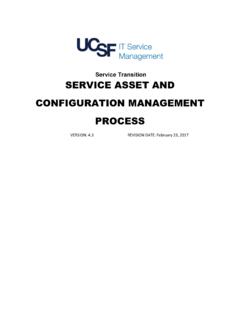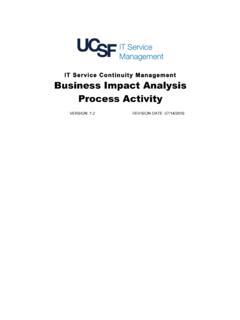Transcription of IT ENTERPRISE PROBLEM MANAGEMENT PROCESS
1 This document contains confidential, proprietary information intended for internal use only and is not to be distributed outside the University of California, San Francisco (UCSF) without an appropriate non-disclosure agreement in force. Its contents may be changed at any time and create neither obligations on UCSF s part nor rights in any third person. IT ENTERPRISE PROBLEM MANAGEMENT PROCESS VERSION January 28, 2014 University of California San Francisco Information Technology Service UCSF Internal Use Only 2 of 33 Information Technology and Service PROBLEM MANAGEMENT PROCESS UCFST able of Contents 1 DOCUMENT INFORMATION 3 ABOUT THIS DOCUMENT 3 WHO SHOULD USE THIS DOCUMENT?
2 3 SUMMARY OF CHANGES 3 REVIEW AND APPROVAL DISTRIBUTION LIST 3 2 INTRODUCTION 4 MANAGEMENT SUMMARY 4 GOAL OF PROBLEM MANAGEMENT 4 PROBLEM MANAGEMENT MISSION STATEMENT 4 BENEFITS 4 PROCESS DEFINITION 6 OBJECTIVES 6 DEFINITIONS 7 SCOPE OF PROBLEM MANAGEMENT 10 INPUTS AND OUTPUTS 10 METRICS 11 3 ROLES AND RESPONSIBILITIES 11 PROBLEM MANAGEMENT PROCESS OWNER 11 PROBLEM MANAGER 13 SUPPORT GROUP STAFF 16 FUNCTIONAL MANAGERS 17 SERVICE DESK 17 SERVICE OWNER 18 PROBLEM OWNER 19 PROBLEM ANALYST 19 PROBLEM REPORTER 20 PROBLEM MANAGEMENT REVIEW TEAM 20 SOLUTION PROVIDER GROUP 20 INTEGRATION WITH OTHER PROCESSES 20 4 PROBLEM CATEGORIZATION AND PRIORITIZATION 22 CATEGORIZATION 22 PRIORITY DETERMINATION 23 WORKAROUNDS 23 KNOWN ERROR RECORD 24 MAJOR PROBLEM REVIEW 24 5 PROCESS FLOW 25 HIGH LEVEL REACTIVE PROBLEM MANAGEMENT FLOW 25 SWIM LANE FLOW DIAGRAM 26 PROCESS ACTIVITIES 27 6 RACI MATRIX 31 ROLE DESCRIPTION 31 ROLE MATRIX 31 7 REPORTS AND MEETINGS 32 CRITICAL SUCCESS FACTORS 32 KEY PERFORMANCE INDICATORS 32 REPORTS 33 8 PROBLEM POLICY 33 UCSF Internal Use
3 Only 3 of 33 Information Technology and Service PROBLEM MANAGEMENT PROCESS UCFS1 Document Information About this document This document describes the PROBLEM MANAGEMENT PROCESS . The PROCESS provides a consistent method to follow when working to resolve severe or recurring issues regarding services from the UCSF IT ENTERPRISE . Who should use this document? This document should be used by: IT ENTERPRISE personnel responsible for the restoration of services and for PROBLEM root cause analysis/remediation. IT ENTERPRISE personnel involved in the operation and MANAGEMENT of the PROBLEM PROCESS .
4 Summary of changes This section records the history of significant changes to this document. Where significant changes are made to this document, the version number will be incremented by Where changes are made for clarity and reading ease only and no change is made to the meaning or intention of this document, the version number will be increased by Version Date Author Description of change 1/28/2014 Jeff Franklin Initial version Review and Approval Distribution List Name Network Server DNS Application IT Facilities UCSF Internal Use Only 4 of 33 Information Technology and Service PROBLEM MANAGEMENT PROCESS UCFS2 Introduction MANAGEMENT Summary This document provides both an overview and a detailed description of the UCSF IT ENTERPRISE PROBLEM MANAGEMENT PROCESS and covers the requirements of the
5 Various stakeholder groups. The PROBLEM MANAGEMENT PROCESS is designed to fulfil the overall goal of unified, standardized and repeatable handling of all Problems managed by UCSF IT ENTERPRISE . PROBLEM MANAGEMENT is the PROCESS responsible for managing the lifecycle of all problems. The PROBLEM MANAGEMENT PROCESS works in conjunction with other IT ENTERPRISE processes related to ITIL and ITSM in order to provide quality IT services and increased value to UCSF. Goal of PROBLEM MANAGEMENT The goal of PROBLEM MANAGEMENT and Incident MANAGEMENT can be in direct conflict.
6 Both processes aim to restore unavailable or affected service to the customer. The Incident MANAGEMENT function s primary goal is to restore this service as quickly as possible whereas the speed, with which a resolution for the PROBLEM is found, is only of secondary importance to the PROBLEM MANAGEMENT PROCESS . Investigation of the underlying cause of the PROBLEM is the main concern of the PROBLEM MANAGEMENT PROCESS . PROBLEM MANAGEMENT activities result in a decrease in the number of incidents by creating structural solutions for errors in the infrastructure and provide Incident MANAGEMENT with information to circumvent errors to minimize loss of service.
7 The PROBLEM MANAGEMENT PROCESS has both reactive and proactive aspects. The reactive aspect is concerned with solving problems in response to one or more incidents. Proactive PROBLEM MANAGEMENT focuses on the prevention of incidents by identifying and solving problems before incidents occur. The primary goals of PROBLEM MANAGEMENT are to: Prevent problems and resulting incidents from happening. Eliminate recurring incidents. Minimize the impact of incidents that cannot be prevented. PROBLEM MANAGEMENT Mission Statement To maximize IT service quality by performing root cause analysis to rectify what has gone wrong and prevent re-occurrences.
8 This requires both reactive and proactive procedures to effect resolution and prevention, in a timely and economic fashion. Benefits PROBLEM MANAGEMENT works together with Incident MANAGEMENT , Change MANAGEMENT , and Configuration MANAGEMENT to ensure that IT service availability and quality are increased. When incidents are resolved, information about the resolution is recorded. Over time, this information is used to reduce UCSF Internal Use Only 5 of 33 Information Technology and Service PROBLEM MANAGEMENT PROCESS UCFSthe resolution time and identify permanent solutions, reducing the number of recurring incidents.
9 This results in less downtime and less disruption to the UCSF s critical systems. Benefits Overview to the Service Delivery Organizations Better first-time fix at the Service Desk Departments can show added value to the organization Reduced workload for staff and Service Desk (incident volume reduction) Better alignment between departments Improved work environment for staff More empowered staff Improved prioritization of effort Better use of resources More control over services provided Benefits Overview to the Customer Organizations Improved quality of services Higher service availability Improved user productivity Additional benefit details realized from adopting PROBLEM MANAGEMENT .
10 Risk Reduction Benefit PROBLEM MANAGEMENT reduces incidents leading to more reliable and higher quality IT services for users. Cost Reduction Benefit Reduction in the number of incidents leads to a more efficient use of staff time as well as decreased downtime experienced by end-users. Service Quality Improvement Benefit PROBLEM MANAGEMENT helps the UCSF IT ENTERPRISE organization to meet customer expectations for services and achieve client satisfaction. By understanding existing problems, known errors and corrective actions, the Service Desk has an enhanced ability to address incidents at the first point of contact.




